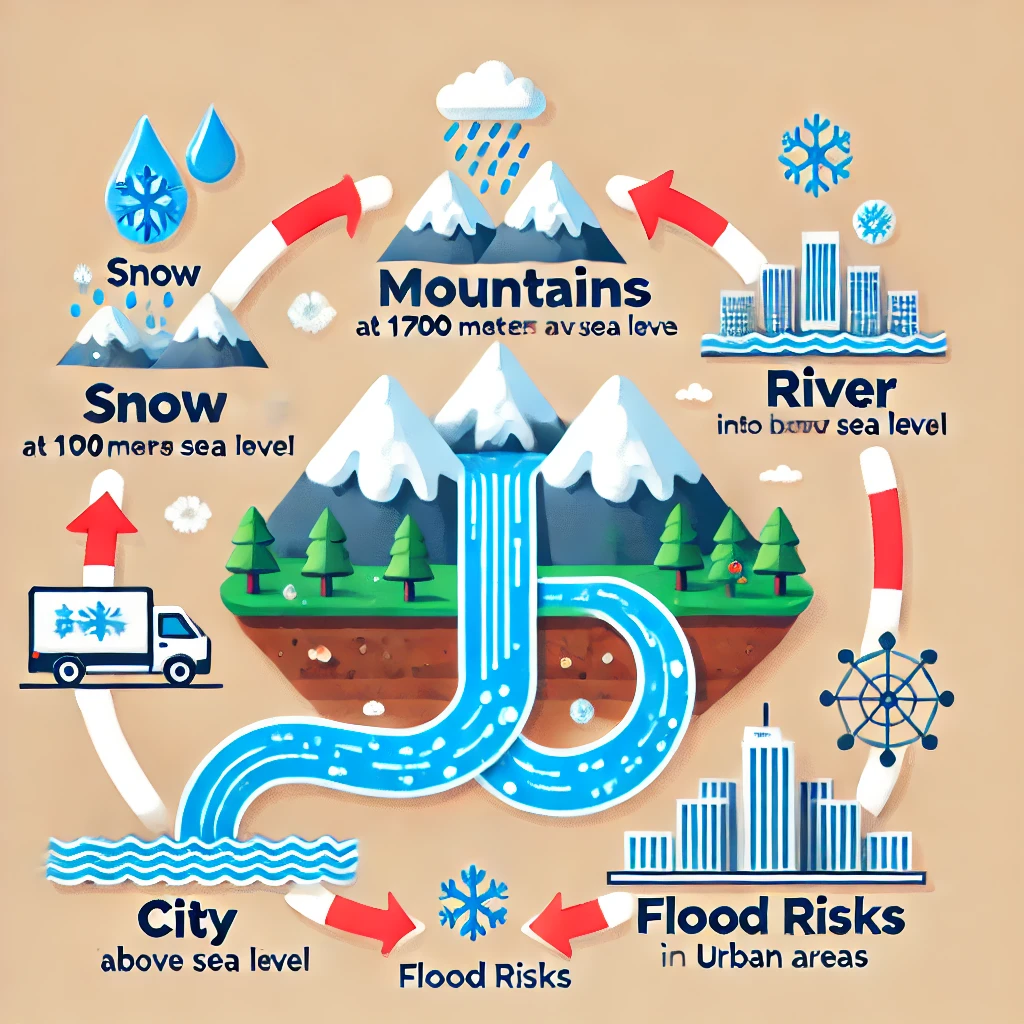Abstract
Beirut River, a seasonal watercourse originating from Ain Delbe and Nahr El Delbe, collects rainfall and snowmelt from 1,700 meters above sea level before reaching the Mediterranean in just 30 minutes. This rapid flow increases the risk of urban flooding, while poor water management has led to severe pollution and underutilization of riverbanks. This case study explores a strategic approach to transforming Beirut River into a resilient, sustainable, and economically valuable urban waterway, drawing inspiration from Dutch water management expertise.
Introduction
Historically, Beirut River served as a vital water resource, yet today it functions primarily as an open drainage system, exacerbating urban flooding, pollution, and land mismanagement. Lebanon faces increasing challenges due to climate change, unregulated urban expansion, and inadequate infrastructure. However, international models, particularly from the Netherlands, demonstrate how strategic flood control, water treatment, and urban redevelopment can turn water bodies into assets rather than liabilities.
This case study examines how integrating smart technologies, sustainable urban planning, and renewable energy solutions can redefine the role of Beirut River, enhancing climate resilience, public health, and economic development.
Problem Statement
Key Challenges
- Uncontrolled Water Flow & Flooding:
- Snowmelt and heavy rainfall from 1,700m elevation reach Beirut in under 30 minutes, leading to rapid and unpredictable flood surges.
- Absence of flood retention basins and controlled discharge systems worsens urban flooding.
- Severe Water Pollution:
- Industrial and domestic wastewater discharge contaminates the river.
- Absence of real-time water quality monitoring limits pollution control.
- Underutilized Urban Land Along Riverbanks:
- Riverbanks remain neglected, rather than being used for public spaces, sustainable agriculture, or renewable energy.
- The lack of urban integration results in inefficient land use and lost economic opportunities.
Global Best Practices: Lessons from the Netherlands
The Netherlands, a global leader in water management, has successfully transformed urban waterways using:
1. Advanced Flood Control & Drainage Systems
- Automated flood barriers and reservoirs to manage sudden water surges.
- Multi-functional water retention areas that absorb excess rainfall and prevent urban flooding.
2. Smart Water Monitoring & Pollution Control
- IoT-based water sensors for real-time monitoring of pollution levels and water flow.
- Natural filtration systems such as wetlands and biofilters to improve water quality.
3. Integrated Urban Waterways & Sustainable Development
- Green riverbank development combining public parks, cycling paths, and urban agriculture.
- Hydropower and solar integration within water channels to generate clean energy.
These strategies have turned Dutch cities like Rotterdam and Amsterdam into global models for urban water management.
Proposed Solutions for Beirut River
1. Smart Flood Control & Drainage Infrastructure
- Construct underground rainwater retention basins to store excess flow and release it gradually.
- Install automated floodgates to regulate water discharge during peak flow events.
- Implement permeable pavement and green drainage systems to reduce surface runoff.
2. Pollution Management & Water Treatment
- Establish natural filtration wetlands along riverbanks to absorb pollutants.
- Deploy real-time IoT monitoring systems for tracking water quality and detecting contamination sources.
- Introduce strict wastewater regulations and industrial treatment requirements.
3. Renewable Energy Integration
- Install micro-hydro turbines in high-flow sections of the river to generate sustainable electricity.
- Use solar-powered water aerators to enhance oxygenation and prevent stagnation.
- Develop a hybrid energy system combining solar, hydro, and battery storage for urban power supply.
4. Riverbank Redevelopment & Urban Integration
- Transform riverbanks into eco-friendly public spaces, incorporating pedestrian walkways, cycling lanes, and recreational areas.
- Establish urban hydroponic and aquaponic farms along the river to promote local food production.
- Develop floating gardens and water plazas that serve as both aesthetic and functional flood buffers.
Challenges & Feasibility
Key Implementation Barriers
- Technical & Engineering Challenges:
- Managing the fast water flow requires precision flood control engineering.
- Balancing urban expansion with sustainable water management.
- Financial & Political Constraints:
- Large-scale infrastructure requires significant funding and governmental commitment.
- Regulatory hurdles in land use planning and environmental enforcement.
- Public Awareness & Stakeholder Engagement:
- Need for community involvement and advocacy to ensure long-term sustainability.
- Encouraging private-sector investment in sustainable development initiatives.
Opportunities for Implementation
- International Collaboration: Partnering with Dutch water management experts for knowledge transfer.
- Public-Private Partnerships (PPPs): Engaging engineering firms, environmental organizations, and investors.
- Smart Infrastructure Funding: Leveraging climate finance and international grants for sustainability projects.
Conclusion
The transformation of Beirut River presents a strategic opportunity for Lebanon to demonstrate leadership in urban resilience and smart water management. By leveraging flood control engineering, real-time monitoring, and sustainable urban design, Beirut can convert its primary waterway into an environmentally and economically valuable asset.
This case study underscores the urgent need for a collaborative, technology-driven, and ecologically responsible approach to reclaim Beirut River.
Call to Action
Lebanon stands at a crossroads: continue allowing Beirut River to deteriorate, or harness innovation to create a world-class urban waterway. With the right vision, investment, and governance, this transformation can set a regional precedent for sustainable city planning and climate adaptation.
The time for action is now


